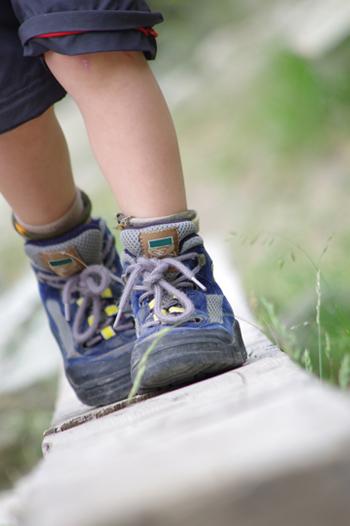Up, over, under, through
Duration/age

You can make an obstacle course with your child inside or outside. Work together to discover what you have around home that you can use to make the obstacles. Try and build different challenges that your child can walk on, go up, over, under or through.
Make obstacles that your child can balance on. You could use something like a flat piece of wood or a masking tape line.
We need something you can balance on - what could we use? How about this piece of wood?
What about climbing over or under? You could use a large cardboard box for a tunnel, or a pile of cushions that can be scaled like a mountain.
Up and over. It’s wobbly, but you can do it. Hold on tight. Don’t worry, I’ve got you.
You could use plastic cones or a line of toys for your child to weave through.
Run around the teddy, then the truck, then the doll, then the giraffe. Yay, you made it!
You can hang some things up high and encourage your child to reach and stretch to touch them. Try balloons or a soft ball in a stocking. Your child can try and hit them with a bat. To complete the course you could make a hurdle by filling two large plastic milk containers with water and balancing a broom handle through them.
Can you jump over the hurdle? One, two, three, jump.
Materials you will need
- Toys
- Planks of wood
- Masking tape
- Cushions
- Broom handle
- Milk containers
- Cardboard box
- Plastic cones
- Stocking
- Bat and ball
Alternative tools
- Cardboard
- Texta or crayon
Skills this activity improves
Why does this matter?
Helping you to plan the different obstacles gives your child an opportunity to solve problems such as ‘What could we use to make them?’, or ‘How high can you jump?’.
Playing with the obstacles gives children a chance to use and develop their big muscles.
Your child will be learning the concepts of up, over, under, and through as they play and finding out how their body feels in space.
What does this lead to?
Problem-solving is an important skill that helps children in everyday life and in school. It helps them to look at alternatives and think about possibilities.
Gross, or big, muscle development helps children to build their strength, become more active and will later help with being able to write effectively.
When children have lots of bodily practice, especially with spatial concepts like these, they will gain a true hands-on understanding, rather than it being just an abstract concept.
Language to use
- Up, down
- Over, under
- Through, around
- Climb, jump, crawl, balance
- Start, finish
- Tape, cushion
- Fast, slow, careful
- Obstacle, course
Questions to use
- Which part do you like the best?
- Is that tricky for you? That’s okay, just try again.
- What else can we add to the course?
Useful tips
- For safety information visit www.parenting.sa.gov.au
- You might also like to take a look at the Baby obstacle course activity.
- Remember to talk to your child in your home language.
More ideas
More ideas
- Use a timer to see how long it takes to get through the course.
- Make some places in your obstacle course where your child can follow instructions. ‘Stand on the mat and clap seven times’. Make signs so they know what to do. Remember to save them for next time.
Variation by age
Three to five year olds
- Go to the playground and find what else you can go up, over, under and through. It might not just be playground equipment.
- Try a chalk course. On a footpath or driveway draw instructions and diagrams for your child to follow. These could include ‘twirl’ with a circle and arrows, ‘stamp and growl’ with footprints, ‘star jumps’ with a star, and so on.
Questions to ask
- What can you climb over?
- Is there anywhere to climb through?
- What do you think this writing says?
- This one tells you to do star jumps. How many can you do?
Language to use
- Jump, twirl, stamp, growl
- One, two, three
- Some, lots


